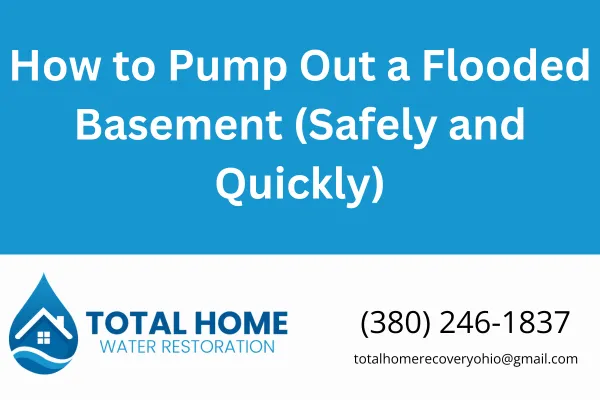
How to Pump Out a Flooded Basement (Safely and Quickly)
How to Pump Out a Flooded Basement (Safely and Quickly)
If your basement's full of water, don't panic. Whether it's from heavy rain, a broken pipe, or a sump pump failure, the first step is staying safe. I’m Tyler Zimmerman, owner of Total Home Water Restoration, and I've helped dozens of homeowners in Grove City and the Columbus area recover from exactly this kind of disaster.
Here’s how to pump out your flooded basement the right way—without risking your health, your home, or your wallet.
1. Stop the Water Source
Before anything else, figure out where the water is coming from:
Shut off your main water valve if it's a burst pipe.
If it’s rainwater or storm runoff, wait until the storm passes and the water stops rising.
Never wade into standing water if you can’t confirm the power is off. Call an electrician if necessary.
2. Turn Off Electricity to the Basement
Water and electricity do not mix. Before entering a flooded basement:
Turn off power at the main breaker (if you can reach it safely).
If unsure, call a licensed electrician before stepping in.
3. Wear the Right Gear
Floodwater can be contaminated with sewage, bacteria, and chemicals. Protect yourself with:
Waterproof boots
Gloves (rubber or nitrile)
Goggles and a mask (especially if mold is present)
4. Use the Right Pump
We’ve seen homeowners try everything from buckets to wet/dry vacs. The fastest and safest way to pump out water depends on the amount:
Small flood (1-2 inches):
Wet/dry vacuum (check capacity and use GFCI outlet)
Moderate flood (2 inches – 1 foot):
Portable sump pump with a garden hose or discharge hose
Severe flood (more than 1 foot):
Gas-powered trash pump or submersible pump
Pump out in stages to avoid foundation damage (remove 1/3 of the water every 24 hours if the basement is deeply flooded)
5. Dry Out the Basement
Once the water’s out, it’s time to dry everything:
Use high-powered fans and dehumidifiers (multiple units for large spaces)
Remove wet carpet, drywall, and insulation if soaked
Check for hidden moisture behind walls, under flooring, or inside cavities
We follow IICRC S500 guidelines for water damage restoration to ensure your home is dried thoroughly and safely.
6. Sanitize to Prevent Mold and Bacteria
After a flood, disinfection is non-negotiable:
Use EPA-registered disinfectants
Focus on floors, walls, and anything touched by water
Don’t just spray and walk away—clean surfaces first, then disinfect
For mold-prone homes or high-risk cases, we follow ANSI/IICRC S520 mold remediation protocols.
7. Call a Professional If...
You see signs of mold (musty smell, discoloration)
The water was contaminated (sewage, gray water)
You’re unsure how to dry hidden spaces
You want a certified team to handle it safely and quickly
Need Help Now?
If you’re in Grove City, Columbus, or anywhere nearby, call us at 380-246-1837. We’ll get there fast, pump out the water, and help you prevent long-term damage.
“From disaster to done right. We fix it like it’s our own home.” – Tyler Zimmerman
FAQ: Flooded Basement Pump Out
Q: Is it safe to pump out a basement all at once?
No. If the basement is severely flooded, pumping too quickly can cause the walls to collapse due to pressure imbalance. Do it in stages.
Q: Can I use bleach to sanitize the basement?
Bleach can be part of disinfection, but it's not effective on porous surfaces like wood or drywall. Use professional-grade products.
Q: Will insurance cover flooded basement cleanup?
Depends on your policy. Flood damage is usually not covered unless you have specific flood insurance. We can help you document everything for your claim.
Need help now or want a free inspection? Call Total Home Water Restoration at 380-246-1837 or visit us at 4141 Hoover Rd, Grove City, OH 43123.
